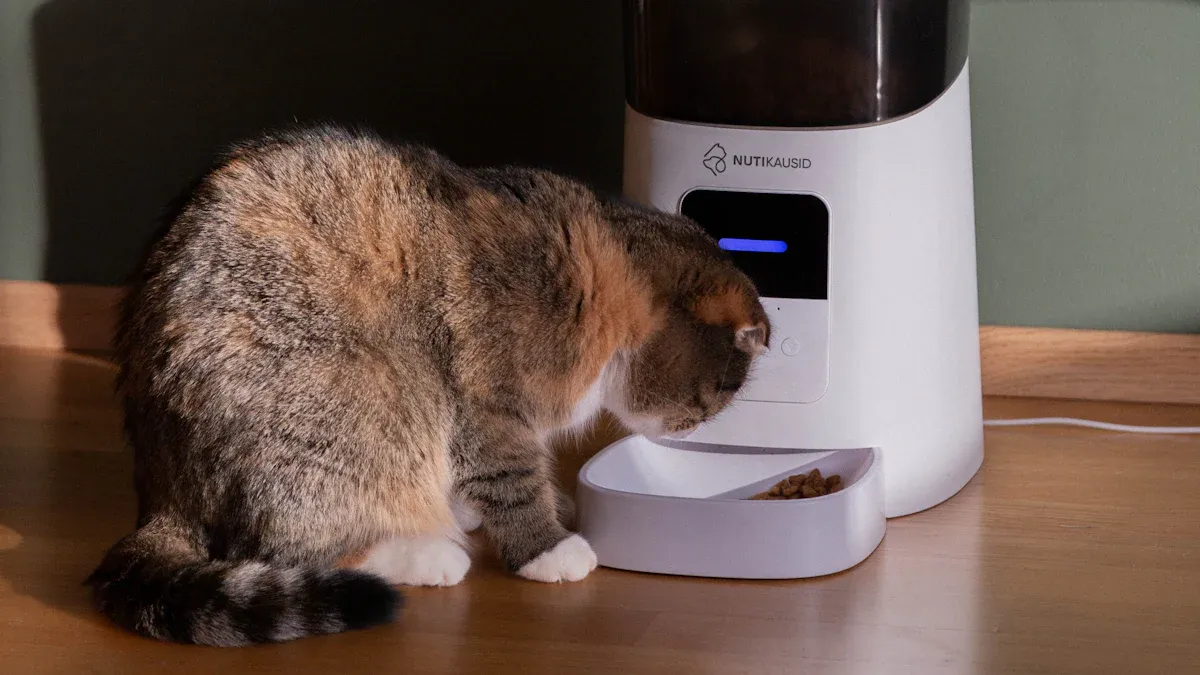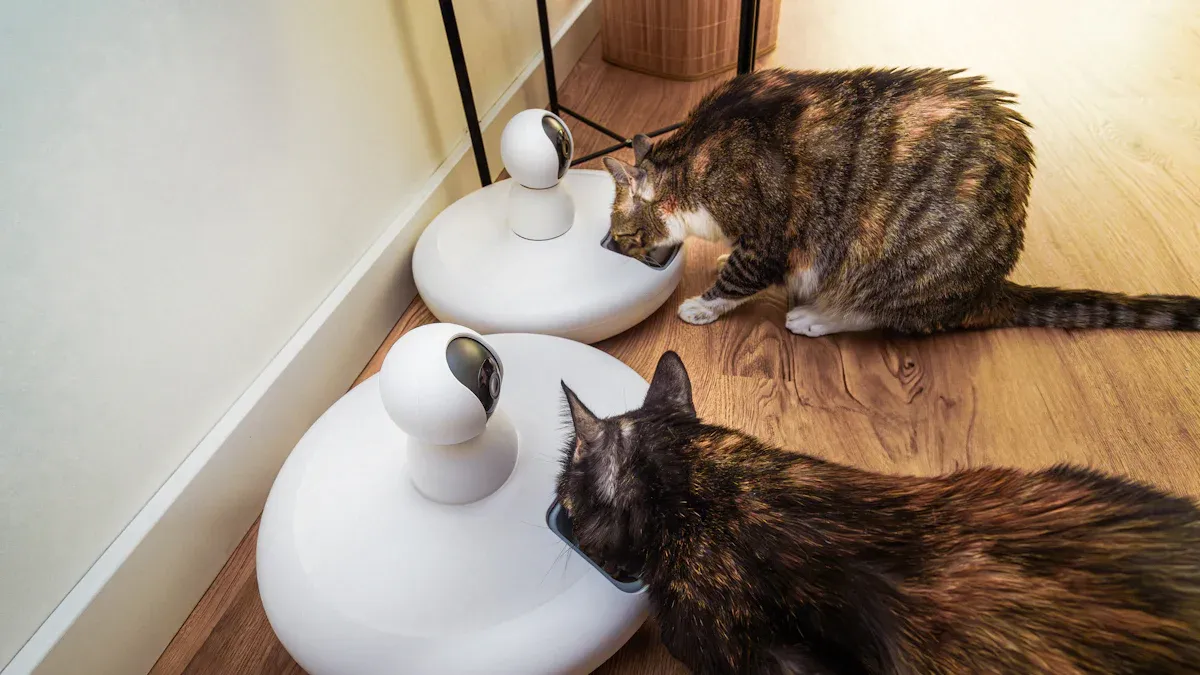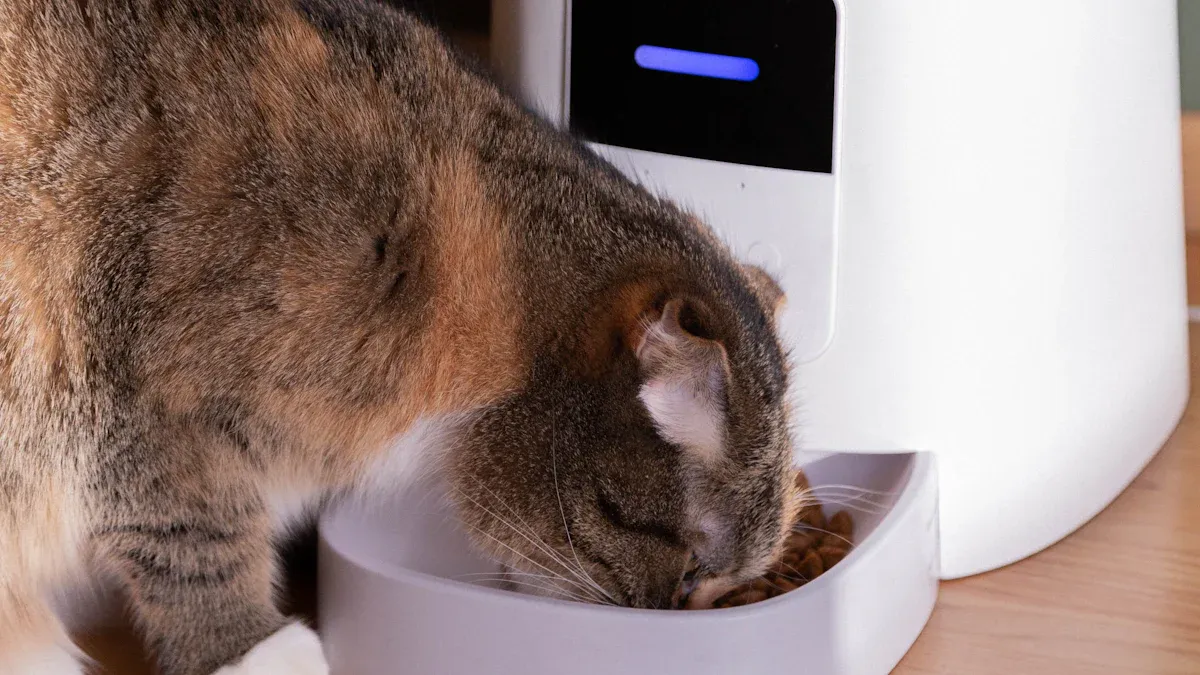
The demand for innovative pet care solutions has surged, creating a lucrative opportunity for businesses offering advanced products like the Pet Automatic Feeder Dog Accessories Long-Range WiFi Smart Automatic Pet Feeder. In the US, high disposable incomes and busy lifestyles drive the need for premium pet care. Europe follows closely, with countries like Germany and France embracing smart pet technology. North America leads the global market, holding 59% of the share, valued at $1.25 billion in 2023. This growth reflects a broader trend, as the global pet tech market is projected to expand from $4.98 billion in 2023 to $11.72 billion by 2030, with a CAGR of 13.0%.
Key Takeaways
- More people are getting pets, and lives are busier. This is making smart pet feeders very popular. Companies can make money by creating new and useful products.
- Long-range WiFi helps owners take better care of pets. It lets them check and change feeding times from far away. Pets get their meals on time, even if owners are not home.
- Smart feeders keep pets healthy by giving the right food amounts. They also make sure pets eat at the same times daily. This helps stop weight gain and keeps pets happy and healthy.
Growing Demand for Pet Automatic Feeder Dog Accessories
Rising Pet Ownership Trends in the US and EU
Pet ownership continues to rise across the US and EU, creating a growing market for innovative pet care solutions. I’ve observed that millennials and Gen Z are leading this trend, with many treating pets as family members. Urban living and busy schedules further drive the demand for products like the Pet Automatic Feeder Dog Accessories Long-Range WiFi Smart Automatic Pet Feeder.
- Approximately 70% of US households now own a pet, reflecting a significant increase in pet ownership.
- Single-person households, particularly in urban areas, are adopting automatic feeders to ensure their pets receive consistent care.
- The dog segment dominates the market, with a projected CAGR of 9.1% through 2031.
| Year | Market Size (USD) | Growth Rate (CAGR) |
|---|---|---|
| 2024 | 655.6 Million | 9.6% |
| 2034 | 1.64 Billion | N/A |
These statistics highlight the immense potential for businesses to cater to this growing demand.
Consumer Shift Toward Smart Home and Pet Care Devices
The integration of smart home technology into pet care has transformed how owners interact with their pets. I’ve noticed that features like remote monitoring and smartphone app control are becoming essential for modern pet owners. In North America, where the market holds 59% of the global share, this shift is particularly evident.
Consumers are drawn to the convenience of managing their pets’ diets remotely. The Pet Automatic Feeder Dog Accessories Long-Range WiFi Smart Automatic Pet Feeder aligns perfectly with this trend, offering advanced features that simplify pet care. This shift reflects a broader desire for tech-enabled solutions that enhance daily life.
Limitations of Traditional Feeders and the Need for Smart Solutions
Traditional feeders often fall short in meeting the needs of today’s pet owners. They lack the precision and flexibility required for effective pet care.
- Portion control is often inaccurate, leading to overfeeding or underfeeding.
- Scheduled feeding is not possible, disrupting pets’ routines.
- Monitoring pets’ eating habits is challenging, making it harder to manage their health.
| Feature | Description |
|---|---|
| Portion Control | Allows owners to set exact food amounts per meal, aiding in effective diet management. |
| Feeding Schedules | Enables scheduling of meal times, beneficial for pets with dietary restrictions. |
| Remote Monitoring | Offers features like feeding history tracking and built-in cameras for observing pets while eating. |
Smart feeders address these limitations by providing precise portioning, customizable schedules, and remote monitoring capabilities. These features not only improve pet health but also offer peace of mind to owners.
Technological Advantages of Long-Range WiFi Smart Automatic Pet Feeder

Remote Monitoring and Control for Pet Owners
Long-range WiFi technology revolutionizes how pet owners manage their pets’ feeding routines. With features like IoT-enabled remote monitoring, owners can control feeding schedules and portion sizes from anywhere using a smartphone. This capability ensures pets receive meals on time, even when owners are away.
For instance, continuous monitoring provides real-time data on pets’ eating habits, which can help detect health issues early. Owners can track activity levels, nutrition, and even sleep quality, offering insights into their pets’ overall well-being. These features strengthen the bond between owners and their pets by ensuring consistent care.
| User Metric | Benefit |
|---|---|
| Early detection of health issues | Enables timely interventions by identifying health deterioration before clinical signs appear. |
| Continuous monitoring | Provides real-time data on vital signs and behaviors, facilitating proactive health management. |
Integration with Smart Home Ecosystems
The integration of automatic pet feeders with smart home ecosystems enhances convenience and functionality. Owners can manage feeding schedules, monitor food consumption, and receive real-time updates through connected devices. These feeders also allow customization based on individual pet needs, ensuring dietary requirements are met.
Sophisticated models, like the Pet Automatic Feeder Dog Accessories Long-Range WiFi Smart Automatic Pet Feeder, support app-based controls. This feature simplifies pet care by maintaining consistent feeding routines and reducing the risk of overfeeding. Additionally, partnerships with veterinarians enable tailored feeding plans for pets with specific dietary needs.
| Feature | Benefit |
|---|---|
| Remote Control | Manage feeding schedules from anywhere |
| Real-time Updates | Monitor pets’ eating habits in real-time |
| Customization Options | Tailor feeding schedules based on individual pet needs |
Reliable Connectivity Across Long Distances
Long-range WiFi technology, such as Wi-Fi HaLow, offers unparalleled connectivity. Operating in the sub-1 GHz band, it provides a range over 10 times greater than traditional Wi-Fi, covering distances up to 3 kilometers. This ensures reliable performance, even in large homes or outdoor environments.
The technology also supports thousands of devices from a single access point, making it ideal for smart homes with multiple IoT devices. Its lower path loss enhances signal penetration through walls and obstacles, ensuring uninterrupted connectivity. These features make the Pet Automatic Feeder Dog Accessories Long-Range WiFi Smart Automatic Pet Feeder a dependable solution for modern pet care.
Wi-Fi HaLow’s power-saving capabilities further enhance its appeal, enabling multi-year battery operation for IoT devices. This efficiency aligns with the growing demand for sustainable and cost-effective pet care solutions.
Health and Convenience Benefits for Pet Owners

Precision in Portion Control and Feeding Schedules
Smart automatic pet feeders excel in delivering precise portion control and maintaining consistent feeding schedules. I’ve seen how these devices allow pet owners to set exact food amounts for each meal, which is crucial for pets with specific dietary needs. For example, portion sizes can vary based on a pet’s age, activity level, or medical conditions. By dispensing accurate portions, these feeders help prevent overfeeding, a leading cause of obesity in pets.
In the U.S., 56% of dogs and 60% of cats are classified as overweight or obese. This highlights the importance of tools like the Pet Automatic Feeder Dog Accessories Long-Range WiFi Smart Automatic Pet Feeder. It ensures pets receive the right amount of food at the right time, supporting weight management and overall health. Owners can also monitor feeding habits remotely, enabling timely adjustments to their pet’s diet if needed.
Stress Reduction for Busy Pet Owners
Busy schedules often make it challenging for pet owners to maintain regular feeding routines. I’ve noticed that 40 to 50% of pet owners struggle to feed their pets on time. Smart feeders alleviate this stress by automating feeding times and allowing remote management through app controls. Whether at work or traveling, owners can ensure their pets are fed consistently without worry.
These devices also provide peace of mind. Knowing that pets are cared for, even in their absence, reduces anxiety for owners. Features like real-time updates and feeding history tracking further enhance convenience, making pet care seamless and stress-free.
Promoting Pet Health Through Consistent Feeding Practices
Consistent feeding practices are vital for maintaining a pet’s health. Irregular feeding can lead to issues like obesity or digestive problems. Smart feeders address this by ensuring pets are fed at regular intervals, even when owners are away. This consistency supports healthy digestion and energy levels.
For pets with special dietary needs, these feeders offer customizable portion sizes and schedules. Enhanced monitoring capabilities also allow owners to track changes in appetite or eating habits, which can indicate potential health issues. By promoting regular and precise feeding, devices like the Pet Automatic Feeder Dog Accessories Long-Range WiFi Smart Automatic Pet Feeder play a key role in improving pet health and well-being.
Market Trends and Competitive Landscape
Consumer Preferences for Smart and Sustainable Pet Care Products
The demand for smart and sustainable pet care products is growing rapidly. I’ve noticed that millennials and Gen Z are driving this trend, prioritizing natural, organic, and eco-friendly options for their pets. These generations also value convenience, making automated solutions like the Pet Automatic Feeder Dog Accessories Long-Range WiFi Smart Automatic Pet Feeder highly appealing.
| Evidence Type | Details |
|---|---|
| Market Size | Valued at USD 235.41 Billion in 2023, projected to reach USD 384.42 Billion by 2031. |
| Growth Rate | CAGR of 5.6% from 2024 to 2031. |
| Key Drivers | Rising pet ownership, humanization of pets, health and wellness trends, environmental awareness. |
The integration of IoT and AI in smart feeders aligns with these preferences, offering personalized feeding schedules and health monitoring. This shift reflects a broader consumer focus on health, wellness, and sustainability.
Competitive Differentiation in the Smart Pet Feeder Market
The smart pet feeder market is becoming increasingly competitive. Companies are leveraging several strategies to stand out.
- Product Innovation: Businesses invest heavily in R&D to introduce advanced features like real-time monitoring and AI-driven analytics.
- Strategic Partnerships: Collaborations with tech firms enable the integration of cutting-edge technologies into feeders.
- Branding and Marketing Efforts: Effective campaigns build trust and increase product visibility.
- Sustainability Focus: Eco-friendly designs address consumer concerns about environmental impact.
| Strategy | Description |
|---|---|
| Product Innovation | Companies invest in R&D to introduce new features and enhance user experience. |
| Strategic Partnerships | Collaborations with tech firms to integrate advanced features into feeders. |
| Branding and Marketing Efforts | Focus on increasing visibility and building consumer trust through effective branding strategies. |
| Sustainability Focus | Addressing consumer concerns about environmental impact by enhancing eco-friendliness of products. |
These approaches not only differentiate brands but also cater to the evolving needs of tech-savvy and environmentally conscious pet owners.
Growth Projections for the US and EU Smart Pet Care Markets
The US and EU markets for smart pet care products are poised for significant growth. In the US, over 70% of households own pets, driving demand for innovative solutions like automated feeders. The market is projected to grow from USD 5.99 billion in 2025 to USD 8.48 billion by 2030, with a CAGR of 7.20%.
In Europe, the market expansion is fueled by increased spending on pet products and services. E-commerce penetration and a focus on pet health further support this growth. Companies are emphasizing quality and innovation to attract consumers and maintain a competitive edge.
The rising emphasis on pet health and convenience in both regions highlights the immense potential for smart feeders. These devices meet the needs of modern pet owners while addressing market demands for sustainability and advanced technology.
Economic and Environmental Benefits of Long-Range WiFi Smart Automatic Pet Feeder
Cost Savings Through Efficient Feeding Practices
Smart feeders offer significant cost-saving opportunities for pet owners. By controlling portion sizes, these devices reduce the amount of uneaten food left in bowls. This efficiency directly translates to financial savings. Studies show that approximately 30% of pet food goes to waste, which highlights the potential for cost reduction when using automated feeders. Owners can also avoid overfeeding, which not only saves money but also prevents health issues that may lead to costly veterinary bills.
Additionally, the ability to schedule meals ensures that food is dispensed only when needed, eliminating unnecessary waste. This feature is particularly beneficial for multi-pet households, where managing individual feeding routines can be challenging. By optimizing feeding practices, smart feeders provide a practical solution for reducing expenses while maintaining high-quality care for pets.
Reducing Food Waste with Accurate Portioning
Accurate portioning is a game-changer in pet care. Traditional feeding methods often result in overfilled bowls, leading to wasted food. Smart feeders address this issue by dispensing precise amounts of food based on a pet’s dietary needs. This level of control minimizes uneaten food, which has significant environmental implications.
For example, reducing food waste not only conserves resources but also decreases the environmental footprint associated with pet food production and disposal. By promoting efficient feeding practices, devices like the Pet Automatic Feeder Dog Accessories Long-Range WiFi Smart Automatic Pet Feeder contribute to a more sustainable approach to pet ownership.
Sustainability as a Key Selling Point in the US and EU
Sustainability has become a critical factor for consumers in the US and EU. Many pet owners now prioritize eco-friendly products that align with their values. Smart feeders support this trend by promoting responsible feeding practices that minimize waste. These devices also reduce the frequency of food purchases, which lowers the overall demand for production and transportation, further decreasing environmental impact.
In addition, the integration of energy-efficient technologies, such as long-range WiFi, enhances the sustainability of these products. Features like multi-year battery operation reduce energy consumption, making them an attractive option for environmentally conscious consumers. By addressing both economic and environmental concerns, smart feeders stand out as a compelling choice in the growing market for sustainable pet care solutions.
The Pet Automatic Feeder Dog Accessories Long-Range WiFi Smart Automatic Pet Feeder offers unmatched technological, economic, and environmental benefits. Its ability to integrate with smart home ecosystems, reduce food waste, and promote pet health makes it a standout product. The US and EU markets show immense growth potential, as highlighted in the table below:
| Region | Market Size (2019) | Market Size (2034) | CAGR (%) |
|---|---|---|---|
| US | $1.2 Billion | $3.5 Billion | 8.5 |
| EU | $0.9 Billion | $2.8 Billion | 9.2 |
I encourage businesses to seize this opportunity and invest in this thriving market. The demand for innovative pet care solutions continues to rise, making this the perfect time to lead in this space.
FAQ
What makes long-range WiFi smart automatic pet feeders unique?
These feeders offer remote control, precise portioning, and seamless integration with smart home systems. Their long-range WiFi ensures reliable connectivity, even in large homes or outdoor spaces.
Are these feeders suitable for pets with special dietary needs?
Yes, they allow customized feeding schedules and portion sizes. Owners can tailor meals to meet specific dietary requirements, ensuring pets receive the proper nutrition.
How do smart feeders contribute to sustainability?
Smart feeders reduce food waste through accurate portioning. Energy-efficient technologies, like long-range WiFi, minimize power consumption, aligning with eco-conscious consumer values in the US and EU.
Post time: Mar-13-2025